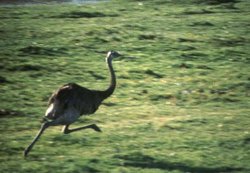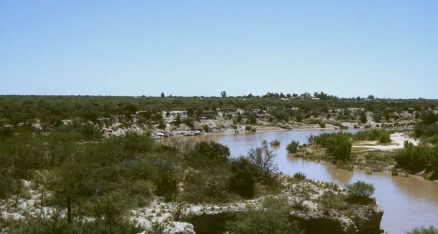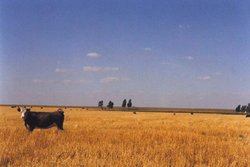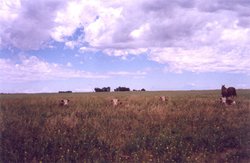Semi-arid Pampas
Introduction The Semi-arid Pampas are found in the center of Argentina (Semi-arid Pampas) . The ecoregion consists of grasslands (Biome) with some shrubs. There are few endemic plants in the ecoregion, but the area has a high biodiversity. Most of the natural vegetation has been replaced by agriculture and cattle ranching. The ecoregion is considered endangered and is regarded as a high priority conservation area at the regional scale.
Location and General Description
The Semi-arid Pampas ecoregion is located in the Buenos Aires, Pampa, San Luis, and Cordoba Provinces in Argentina. This region has sandy or sandy loess soils frequent old and present-day sand dune relief. The rainfall accumulates in extensive lagoons. The climate is dry with annual precipitation averaging around 700 millimeters (mm). Two main rivers, the Colorado and the Salado traverse the ecoregion.
The predominant vegetation is steppe grass, which forms thick mats in the grasslands (Biome). These areas dry out during the dry season and during the cold season, leaving a renewed layer of soil protected by the detritus of the same plants. The vegetative species present in this region are Poa ligularis, Stipa tenuissima, Stipa tricótoma, Stipa filiculmis (flechilla or pasto puna), Panicum urvilleanum, Elionurus muticus, Sorghastrum pellitum, Eragrostis lugens, Bromus brevis, Chloris retusa and other. Shrub species are beginning to show more frequently including Discaria longispina, Baccharis articulata (carquejilla), Geoffroea decorticans (chañar), Prosopis caldenia (caldén) and others.
Biodiversity Features
 Greater rhea (Rhea americana), pampas, Argentina. (Photograph by WWF)
Greater rhea (Rhea americana), pampas, Argentina. (Photograph by WWF) In this ecoregion there are various marshes that are considered unique habitats. Among these we should mention: Complejo Lagunar "Las Tunas - El Hinojo", Sistema Lagunas Encadenadas del Oeste, Dique Paso de las Piedras, Cuenca Chasicó y Región Serrana de Sierra de la Ventana.
The fauna in this ecoregion is also found in the Humid Pampas ecoregion. Some of the common animals include the pampas deer (Ozotoceros bezoarticus celer), the puma (Felis concolor), Geoffroy's cat (Felis geoffroyi), pampa fox (Dusicyon gymnocercus) and the zorrino común (Conepatus chinga). Other mammals in the area are the vizcachas (Lagostomus maximus), the cuis pampeano (Cavia aperea), the nutria (Myocastur coypus), and the opossum (Didelphis albiventris).
Some of the common birds in the area are the ñandú (Rhea americana), the perdiz chica (Nothura maculosa), the martineta colorada (Rynchotus rufescens), and waterfowl such us the gallareta chica (Fulica leucoptera), the cuervillo de cañada (Plegadis chihi), the cigüeña americana (Euxenura maguari) and others.
Among endemic species present in this ecoregion the most notable are Limnornis curvirostris, Cynolebias nonoiuliensis and Liophis elegantísima. Species in danger of extinction are the pampas deer (Ozotoceros bezoarticus celer), which is the most important herbivore in the area, the loica pampeana (Sturnella defilippi), Limosa haemastica, Laterallus spilopterus and Coturnicops notata.
There are approximately 24 species of marine mammals that frequent the coastal areas of the ecoregion. They include four species of seals and three species of sea turtles that can be seen occasionally (among them Dermochelys coriacea, considered vulnerable by IUCN). There are also more than 300 species of marine and coastal birds. This area forms a transitory place for fish, migratory marine birds, marine mammals, and seals. Punta Rasa is an important feeding and resting spot for many migratory bird species including Calidris canutus, C. Fuscicollis, Limosa haemastica, Pluvialis dominica, Charadrius falklandicus, and gaviotines (Sterna hirundo).
Current Status
The semi-arid pampas and the humid pampas are the phytographic territories most suitable to agriculture and cattle grazing and are the most populated areas of Argentina. Man has altered almost the entire area of these two [[ecoregion]s]. Cereals and fodder are planted for cattle grazing, altering in this way the natural vegetation found in this area. A great part of this region has been assigned to agriculture leaving only some relics of the original vegetation in less useable places. However the climatic changes associated with the new technologies and irrigation systems that pretend to change the areas for the better put the biodiversity in the area at serious risk.
There are no protected areas in the ecoregion, despite the fact that it has been declared a maximum priority region for conservation. The semi-arid pampas contain one of the last relics of semi-arid pampas grasses. In 1997 an agreement was signed between Parques Nacionales and the government of the province of San Luis to create a National Park and National and Provincial Reserves, but there has not been any kind of action. Unfortunately the pampas deer population is still affected by poaching. There are also two roads built across an area critical for conservation.
Types and Severity of Threats
There are two severe threats in the region: conversion of remaining natural habitats for agriculture and degradation through over-grazing are severe threats. Burning and draining of lands are also threatening remaining habitats that could possibly affect protected areas.
Justification of Ecoregion Delineation
The delineations for the Semi-Arid Pampas were derived from Daniele and Natenzon, and linework follows their classification of "Sabanas y Pastizales de la Pampa Semiárida (savannas and grasslands (Biome) of the semiarid pampas)" region. Other resources consulted include Cabrera and Morello.
Additional Information on this Ecoregion
- For a shorter summary of this entry, see the WWF WildWorld profile of this ecoregion.
- To see the species that live in this ecoregion, including images and threat levels, see the WWF Wildfinder description of this ecoregion.
- World Wildlife Fund Homepage
Further Reading
- Anderson, D.L., Del Águila, J.A., y A.E. Bernardón. 1970. Las formaciones vegetales de la Provincia de San Luis. Rev. Inv. Agropecuaria INTA, serie 2, Biología y Producción Vegetal, 7(3): 83-153.
- Bertonatti, C.Y.F. González. Lista de Vertebrados Argentinos Amenazados de Extinción. FVSA.
- Cabrera, A.L. 1976. Regiones Fitogeográficas de Argentina. Enciclopedia Argentina de Agricultura y Jardinería. Tomo II. Fascículo I. Editorial ACME S.A.C.I., Buenos Aires, Argentina.
- Canevari P., D.E. Blanco, E. Bucher, G. Castro, e I. Davidson. 1998. Los Humedales de la Argentina. Clasificación, situación actual, conservación y legislación. Wetlands International.
- Daniele, C., and C. Natenzon. 1994. Regiones Naturales de la Argentina. Draft map. Argentina National Parks Department, Buenos Aires, Argentina.
- Dinerstein, E., D.M. Olson, D.J. Graham, A. V. Webster, S. A. Primm, M. P. Bookbinder y G. Ledec. 1995. Una evaluación del estado de conservación de las ecoregiones terrestres de América Latina y el Caribe. Publicado en colaboración con el Fondo Mundial para la Naturaleza, Banco Mundial, Washington, D.C.
- García Fernández, J.J., R.A. Ojeda, R.M. Fraga, G.B. Díaz, y R.J. Baigún. 1997. Mamíferos y aves amenazados de la Argentina. FUCEMA, SAREM, AO del Plata, APN, Buenos Aires, Argentina. ISBN: 9879632508
- Morello, J. 1968. La vegetación de la República Argentina, No. 10: Las grandes unidades de vegetación y ambiente del Chaco Argentino. Buenos Aires, Argentina.
| Disclaimer: This article is taken wholly from, or contains information that was originally published by, the World Wildlife Fund. Topic editors and authors for the Encyclopedia of Earth may have edited its content or added new information. The use of information from the World Wildlife Fund should not be construed as support for or endorsement by that organization for any new information added by EoE personnel, or for any editing of the original content. |


